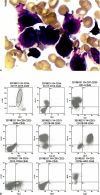Therapy-Related Leukemia following Docetaxel Chemotherapy for Metastatic Hormone-Sensitive Prostate Cancer: A Case Report
- PMID: 39980510
- PMCID: PMC11731904
- DOI: 10.1159/000541722
Therapy-Related Leukemia following Docetaxel Chemotherapy for Metastatic Hormone-Sensitive Prostate Cancer: A Case Report
Abstract
Introduction: Docetaxel is the first-line drug that has been proved to improve the overall survival of men with metastatic hormone-sensitive prostate cancer (mHSPC). For patients who survive the prostate cancer, they may be at risk of secondary neoplasm, especially for the therapy-related myelodysplastic syndrome or therapy-related acute myeloid leukemia (t-AML).
Case presentation: We reported a 44-year-old man with prostate cancer (cT4N1M1c) who developed t-AML following docetaxel chemotherapy. Typically, the t-AML in our case was characterized by an aberrant karyotype t(15;17)(q22;q21).
Conclusions: This case is, to our knowledge, the first time to report a patient with mHSPC who developed therapy-related acute promyelocytic leukemia following docetaxel chemotherapy, suggesting that docetaxel might contribute to the induction of t-AML.
Keywords: Case report; Chemotherapy; Docetaxel; Metastatic hormone-sensitive prostate cancer; Therapy-related acute myeloid leukemia.
© 2024 The Author(s). Published by S. Karger AG, Basel.
Conflict of interest statement
The authors declare that they have no competing interests.
Figures



Similar articles
-
Qualitative and Quantitative Assessment of Patient and Carer Experience of Chemotherapy (Docetaxel) in Combination with Androgen Deprivation Therapy (ADT) for the Treatment of Metastatic Hormone-Sensitive Prostate Cancer (mHSPC).Adv Ther. 2018 Dec;35(12):2186-2200. doi: 10.1007/s12325-018-0825-7. Epub 2018 Nov 10. Adv Ther. 2018. PMID: 30415297 Free PMC article.
-
[Androgen deprivation therapy plus chemotherapy ± androgen receptor-targeting agents for metastatic hormone-sensitive prostate cancer].Urologie. 2023 Apr;62(4):360-368. doi: 10.1007/s00120-023-02029-0. Epub 2023 Feb 10. Urologie. 2023. PMID: 36763112 Free PMC article. Review. German.
-
Comparative assessment of docetaxel for safety and efficacy between hormone-sensitive and castration-resistant metastatic prostate cancer.Urol Oncol. 2019 Dec;37(12):999-1005. doi: 10.1016/j.urolonc.2019.07.005. Epub 2019 Jul 31. Urol Oncol. 2019. PMID: 31377168
-
Effectiveness of Docetaxel for Metastatic Hormone-sensitive Prostate Cancer in Clinical Practice.Eur Urol Open Sci. 2021 Jan 6;24:25-33. doi: 10.1016/j.euros.2020.12.006. eCollection 2021 Feb. Eur Urol Open Sci. 2021. PMID: 34337492 Free PMC article.
-
Darolutamide: A Review in Metastatic Hormone-Sensitive Prostate Cancer.Target Oncol. 2023 Sep;18(5):793-800. doi: 10.1007/s11523-023-00984-4. Epub 2023 Aug 5. Target Oncol. 2023. PMID: 37542594 Free PMC article. Review.
References
-
- Siegel RL, Miller KD, Jemal A. Cancer statistics, 2016. CA Cancer J Clin. 2016;66(1):7–30. - PubMed
-
- Tucci M, Bertaglia V, Vignani F, Buttigliero C, Fiori C, Porpiglia F, et al. . Addition of docetaxel to androgen deprivation therapy for patients with hormone-sensitive metastatic prostate cancer: a systematic review and meta-analysis. Eur Urol. 2016;69(4):563–73. - PubMed
-
- Oroszi G, Brody J, Yang T, Allen SL, Devoe C, Zhang X. Sequential development of two separate therapy-related myeloid neoplasms following radiotherapy for prostate cancer. Leuk Lymphoma. 2016;57(11):2689–92. - PubMed
Publication types
LinkOut - more resources
Full Text Sources

